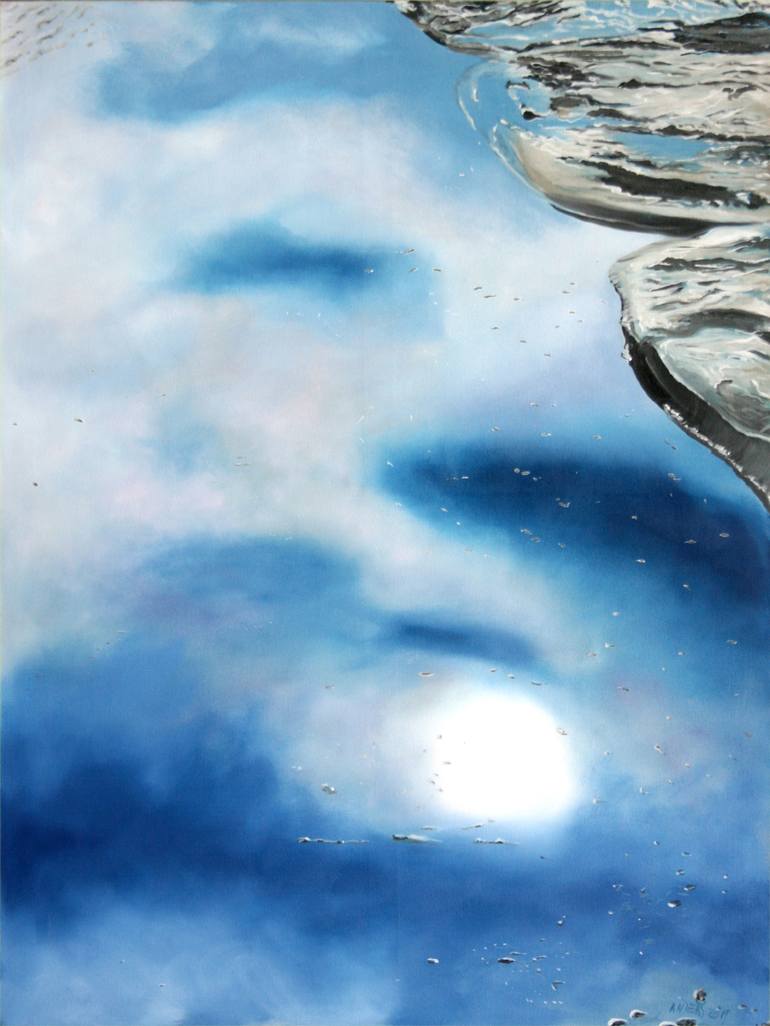





VIEW IN MY ROOM
Cloud face in the mudflats, impression of a beach walk, nr.7 Print
Austria
Select a Material
Fine Art Paper
Select a Size
9 x 12 in ($40)
Add a Frame
White ($80)
Artist Recognition

Artist featured in a collection
About The Artwork
A cloud face in the mudflats, impression of a beach walk, nr.7 This picture was also taken during my beach walk in Grado/Italy and is one of many from the cycle – impressions of a beach walk. Grado is a lagoon town on the northern Adriatic Sea in the Gulf of Venice and true at the time of the Austrian/Hungarian monarchy also a spa town. Grado is known for its shallow beach and to get into deeper waters you sometimes have to go up to 300 meters and further out. Especially when the tide is low and the water has retreated, really beautiful extended beach runs are possible. And if you stroll over these puddles and dangle with your soul, feel the warm evening sun beams on your skin, you know you are on holiday. Such a beach is not only flat, there are very slight elevations and reductions. And if you just walk there and enjoy the vastness, you overlook what nature conjures up in front of you or under your feet. Seeing things isnot for everyone, but I remember that we all like to see different things in the clouds every now and then. So why not also in the reflection of the clouds in the water? In combination with the sand islands, some of which are washed over and the reversal effect of the water reflection, nature proves once again that it is more surreal than all the surrealists of this world put together. But stop, it's reality. In this work I consciously distanced myself from my usual technique, the drop and the acrylic paint. Certain pictures and subjects want to be worked out differently. So also this one where I chose the oil paint. In spite of everything, I remain true to the theme that has been set me. Here too, a relatively small area is enlarged, lifted into another dimension. Nature is something unspeakably fascinating, and so I have succumbed to the temptation that what I see, perceive, and if only with a single small walk, to take pictures, much like a poet can do with words.
Original Created:2019
Subjects:Water
Details & Dimensions
Print:Giclee on Fine Art Paper
Size:9 W x 12 H x 0.1 D in
Size with Frame:14.25 W x 17.25 H x 1.2 D in
Frame:White
Ready to Hang:Yes
Packaging:Ships in a Box
Shipping & Returns
Delivery Time:Typically 5-7 business days for domestic shipments, 10-14 business days for international shipments.
Handling:Ships in a box. Art prints are packaged and shipped by our printing partner.
Ships From:Printing facility in California.
Have additional questions?
Please visit our help section or contact us.
Austria
In Erik Oliver Anders' work, there is something that connects his different subjects, something that is more than just a formal singularity or a stylistic characteristic: it is the “drop of paint”. His painting techniques are inspired by the early atomic teachings of Ancient Greece (for example those of philosopher Democritus, who lived around 450 BC) or by the Indian "Milinda Panha", a dialogue between the Buddhist sage Nāgasena and the Indo-Greek king Menander I about the whole and its parts (200-100 BC), as well as by modern particle physics. Nothing in essence is as it appears. Most of what we consider as solid matter is void. For his pictures, Erik Anders uses a basic building block: the drop of paint. Here we find echoes of the pointillism of Georges Seurat from the 1880s - or clear parallels to the action painting of Jackson Pollock in the first half of the 20th century. Erik Anders also refers to a series of his works as "drippings". Erik Anders’ intention is to control the drop, to use it purposefully. Over the past 15 years, he has become a "tamer” of paint drops. First, he lets the drop flow on the canvas (Anders also mentions Nitsch as a model). Lines are created. Rotating the canvas also changes the direction of the flow and, consequently, the course of the lines. By doing so, he creates his basic elements: points and lines. Grids are created, superimposed in several layers, forming abstract structures, yet still evoking the impression of buildings, cities and sceneries. This interplay of literalism and abstraction also recalls Kandinsky's theoretical work "On the Spiritual in Art" (1910) or Japanese Buddhism, freely formulated as "Zen, or the art of letting drops fall". Erik Oliver Anders has a very precise idea and sketches of each of his paintings. Then, he sets out to translate this idea as accurately as possible on a big canvas. Random forms are excluded as far as possible. In several layers, partly reminiscent of Mark Rothko’s glazes, spatial effects are created, which play with concealing and transparency. With this elaborate painting technique, through different grid structures, drop shapes and sizes, he achieves an almost three-dimensional depth effect and permeability. This permeability and openness is also characteristic of Erik Anders' lifestyle. Always curious, open for new things, quick to take up new topics - especially "funny" ones. He loves to play with elements, but also to take an in-depth view at things.
Artist Recognition

Artist featured by Saatchi Art in a collection
Thousands Of Five-Star Reviews
We deliver world-class customer service to all of our art buyers.
Global Selection
Explore an unparalleled artwork selection by artists from around the world.
Satisfaction Guaranteed
Our 14-day satisfaction guarantee allows you to buy with confidence.
Support An Artist With Every Purchase
We pay our artists more on every sale than other galleries.
Need More Help?